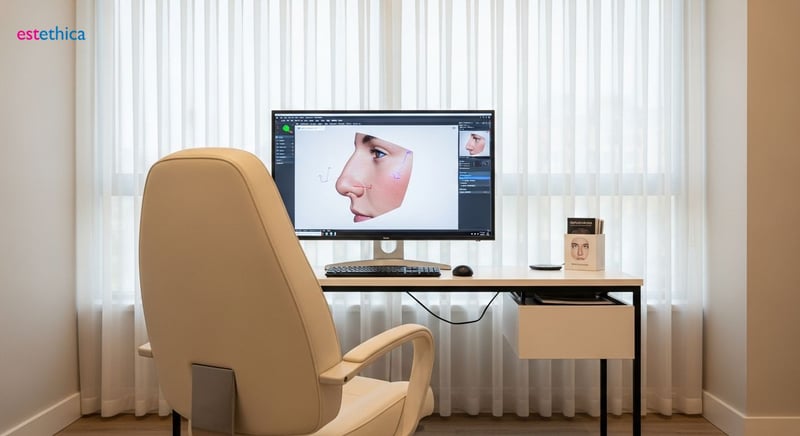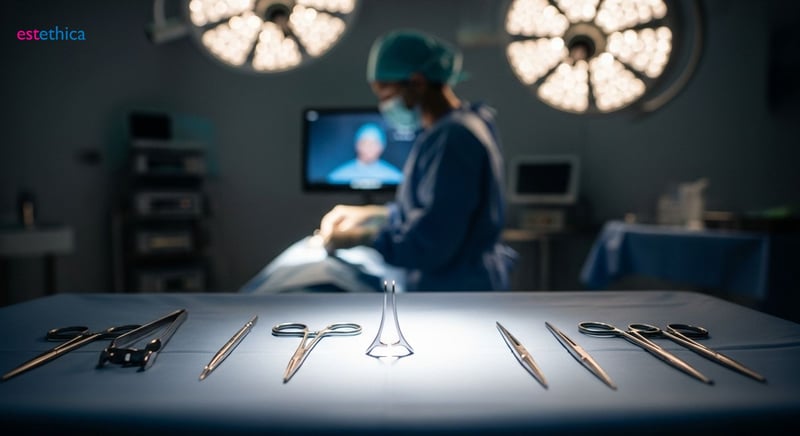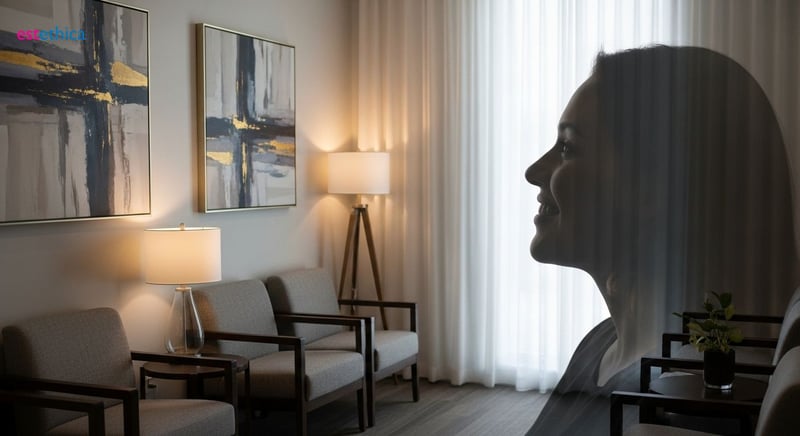Nose Surgery: Reshape Your Confidence, Redefine Your Profile
Transform your profile with rhinoplasty at estethica, where confidence and functionality meet expert care.
Nose surgery, or rhinoplasty, is not just about aesthetic reshaping. It’s a journey towards improved confidence and functional breathing. At estethica, we emphasize safety, expertise, and a patient-centered approach to help you redefine your profile.
Rhinoplasty Techniques: Open vs Closed - Which Is Right for You?
Understanding Open Rhinoplasty
Open rhinoplasty, sometimes called "external rhinoplasty", involves making a small incision on the columella—the strip of skin separating the nostrils. This technique provides a plastic surgeon with unparalleled access and visibility to the underlying nasal structures, including bone and cartilage, allowing for precise reshaping.
- Enhanced Visibility: Offers a direct view of the nasal framework, crucial for intricate modifications.
- Structural Support: Allows for robust reconstruction and reinforcement of nasal structures.
- Versatile Application: Suitable for a wide range of corrections, from major reshaping to addressing breathing issues.
The precision afforded by open rhinoplasty makes it an ideal choice for patients requiring significant nasal reconstruction or those undergoing revision nose surgery, where previous surgical alterations need careful management. Worldwide statistics indicate that approximately 65% of rhinoplasty procedures are performed using the open technique in cases requiring substantial nasal remodeling.
Exploring Closed Rhinoplasty
Closed rhinoplasty, also known as endonasal rhinoplasty, involves performing the entire surgery through incisions made inside the nostrils. The main advantage of this approach is the absence of an external scar. A skilled surgeon can achieve significant aesthetic improvements while minimizing visible signs of surgery. This may be a particularly attractive option for patients concerned about scarring.
- Minimal Scarring: Incisions are made inside the nose, leaving no visible external scars.
- Faster Recovery: Reduced tissue disruption often leads to quicker healing.
- Suitable for Minor Corrections: Ideal for addressing small to moderate nasal imperfections.
Closed rhinoplasty is often favored for patients who need only minor nasal reshaping or have well-defined nasal structures. For instance, someone seeking a slight refinement of the nasal tip or a minor adjustment to the bridge might be an excellent candidate. Around 35% of individuals opt for this technique seeking subtle, yet impactful improvements.

Beyond Aesthetics: Correcting Breathing Problems with Septoplasty
Functional Benefits of Septoplasty with Rhinoplasty
Septoplasty is frequently performed alongside rhinoplasty to address a primary functional concern: a deviated septum. This condition, where the nasal septum is displaced to one side, can cause significant nasal passage obstruction. Septoplasty aims to straighten the septum, thus improving airflow and alleviating chronic congestion. For instance, individuals who experience difficulty breathing through one or both nostrils, frequent sinus infections, or persistent nasal stuffiness may find considerable relief through this combined procedure. At estethica, our approach ensures that the functional improvements are harmoniously integrated with aesthetic enhancements, providing both health benefits and cosmetic satisfaction.
- Improved Breathing: Straightening the septum enhances airflow through the nasal passages.
- Reduced Sinus Infections: Correcting obstructions minimizes the risk of sinus inflammation and infection.
- Enhanced Quality of Life: Alleviating congestion and breathing difficulties leads to better sleep and overall comfort.
The estethica Approach to Comprehensive Nasal Correction
At estethica, our skilled surgeons understand that a successful nose job involves more than just aesthetic refinement; it encompasses essential functional improvements. Septoplasty, when combined with rhinoplasty, offers a holistic solution for patients seeking both cosmetic and health benefits. Our surgeons meticulously assess each patient's nasal structure and breathing issues to create a tailored surgical plan. For example, consider a patient with a visibly crooked nose who also suffers from chronic sinusitis due to a deviated septum. The combination of rhinoplasty and septoplasty can straighten the nose, improve facial symmetry, and significantly reduce sinus problems. This dual approach ensures that the patient achieves a balanced, natural-looking result with enhanced nasal function, underscoring estethica's commitment to comprehensive patient care.
- Initial Consultation: Comprehensive evaluation of nasal structure and breathing issues.
- Customized Surgical Plan: Tailored approach combining aesthetic and functional goals.
- Post-operative Care: Detailed guidance for optimal recovery and long-term results.

Rhinoplasty Recovery: Tips and Timeline for a Smooth Healing Process
Navigating the Initial Post-Operative Phase
The immediate aftermath of rhinoplasty involves managing expected swelling and bruising. These are natural responses to the surgical adjustments made to the nasal structure. Typically, patients can anticipate these symptoms to peak within the first few days following the procedure. To mitigate discomfort, estethica's post-operative guidelines emphasize the importance of keeping the head elevated, applying cold compresses, and adhering to prescribed medication schedules. For instance, gentle walking indoors can promote circulation and reduce swelling. Furthermore, it's advised to avoid strenuous activities, such as heavy lifting or intense exercise, to prevent complications and ensure a smooth recovery. Adhering to a soft diet can also minimize strain on the face during this initial healing period. Approximately 85% of patients report significant improvement in swelling and bruising within the first two weeks by following these guidelines closely.
- Head Elevation: Reduces swelling and promotes drainage.
- Cold Compresses: Minimizes bruising and discomfort.
- Gentle Activity: Enhances circulation without strain.
Long-Term Recovery and Nasal Reshaping
While the initial swelling and bruising subside relatively quickly, the complete recovery from nose surgery is a gradual process. The nose continues to refine its shape over several months, with the final results typically visible up to six months post-surgery. During this time, it's crucial to protect the nose from trauma and follow all post-operative instructions provided by estethica. Regular follow-up appointments allow our surgeons to monitor the healing progress and address any concerns. For example, patients are often advised to avoid wearing glasses directly on the nasal bridge for a few months to prevent pressure on the healing tissues. Additionally, nasal exercises and massage techniques may be recommended to optimize the final aesthetic outcome. Proper skincare, including sun protection, is also essential to maintain the skin's health and appearance. Close adherence to these long-term care recommendations ensures the best possible results and patient satisfaction. Many patients report that the subtle refinements occurring months after surgery contribute significantly to their overall satisfaction. Here estethica provides the support to achieve optimal nasal reshaping.
- Protect from Trauma: Avoid any activities that could impact the nose.
- Follow-Up Appointments: Attend all scheduled check-ups for monitoring.
- Sun Protection: Use sunscreen to protect the skin on and around the nose.

Nasal Reshaping: Exploring Non-Surgical Rhinoplasty Options
Benefits of Non-Surgical Nasal Reshaping
For those seeking subtle changes, non-surgical rhinoplasty offers an alternative. Using dermal fillers, minor aesthetic corrections such as smoothing a bump or adjusting the nasal tip can be achieved without surgery. This option is particularly attractive for those seeking minimal downtime and immediate results. Non-surgical nose surgery is especially appealing to individuals who desire enhancements without the extensive recovery period associated with traditional surgery. Furthermore, this procedure allows for adjustments and refinements over time, providing patients with a degree of flexibility that is not possible with permanent surgical alterations. At estethica, we ensure each patient is well-informed about the possibilities and limitations to align expectations with achievable outcomes, providing a transparent approach to cosmetic enhancements. Around 70% of patients considering a nose job explore non-surgical options.
- Minimal Downtime: Allows for a quick return to normal activities.
- Immediate Results: Provides visible changes shortly after the procedure.
- Adjustable Outcomes: Offers the flexibility to modify results over time.
Ideal Candidates for Non-Surgical Rhinoplasty
Non-surgical rhinoplasty, or liquid nose job, is best suited for individuals with specific types of nasal imperfections. These include those with a small dorsal hump they wish to smooth out, those seeking to refine the nasal tip, or those wanting to improve overall nasal symmetry. It is an excellent option for individuals who are looking for subtle enhancements and are wary of the risks associated with surgical intervention. For example, patients with minor nasal asymmetry can achieve a more balanced appearance through strategic filler placement. Additionally, individuals with a slightly drooping nasal tip can benefit from filler injections that provide a subtle lift. estethica's skilled practitioners carefully assess each candidate to ensure that non-surgical rhinoplasty is the most suitable approach for their unique needs and aesthetic goals. The procedure usually takes between 15 to 45 minutes which makes the rhinoplasty accessible to many patients.
- Initial Assessment: Determine suitability through a detailed consultation.
- Filler Injection: Precise placement to correct minor irregularities.
- Post-Procedure Review: Ensure satisfaction and address any concerns.
Understanding Rhinoplasty: A Comprehensive Guide
Open and Closed Rhinoplasty: Tailored Surgical Techniques for Optimal Reshaping
Patient-Centered Rhinoplasty: Optimizing Recovery and Long-Term Results
Frequently Asked Questions
What are the main differences between open and closed rhinoplasty techniques?
How does septoplasty improve breathing when combined with a nose job?
What key steps can ensure a smooth recovery after rhinoplasty?
Who is an ideal candidate for non-surgical rhinoplasty?
Achieve your aesthetic goals with estethica's world-class services and expert care.
📞 Claim Your Free Consultation!